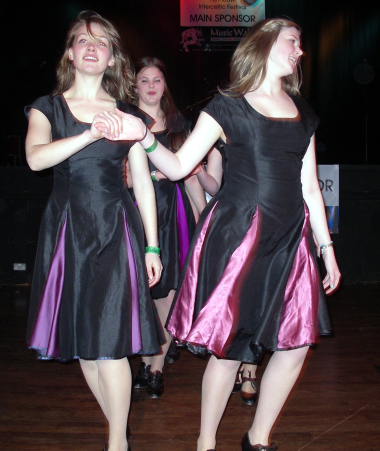|
|
Gwerincymru — o Gymru o’r byd |
|||
|
By MIKE GREENWOOD
I find that it isn’t often that one’s heart is lifted in these miserable, troubled times, but it happened to me on one Friday morning in early June when I was invited to attend a most interesting and enterprising event in the upper Swansea valley. The Miners’ Welfare Hall, or Y Neuadd Les in Ystradgynlais, which has played host to many an A-list act on the folk circuit over recent years, staged a twmpath, or ceilidh, for 130 Year Six primary school children and their teachers. And whilst the event had been approached with a good deal of trepidation by all involved, it turned out to be brilliantly successful.
The project was germinated some months previously at an adult twmpath in the same area, at which retired head-teacher Hywel Williams was calling. Another teacher, Geraint Roberts, was playing in the band that night and the two fell to talking about how wonderful it would be to do this with a hall full of schoolchildren.
By the end of the evening, the discussion had turned into a plan of action, and led to Geraint circulating a letter to each of the local primary schools, suggesting just such an event. He received overwhelming promises of support from all four schools that had been approached, and the plan was passed on to Hywel, who collated a selection of eight dances suitable for teaching to final year pupils. The next step was for Geraint and his colleague, Huw Dylan Owen, to record a CD of appropriate tunes, copies of which Hywel took to each of the schools and demonstrated a few basic steps, outlining to teachers what was being planned.
Meanwhile, Geraint, a trustee of the Welfare in Ystradgynlais, gathered his fellow trustees and talked to them about using the Welfare, conveniently central to the four schools, for the proposed twmpath. The hall manager, Wynne Roberts, was more than happy to help with running the event, and Geraint set about assembling a band whilst Hywel brushed up his calling notes.
The time and place had just happened to be right. Recent restructuring, forcing school closures and amalgamations within the valley’s primary education establishments had pulled together pupils from different backgrounds into just four super-primaries - Ysgol Bro Tawe, Ysgol Dyffryn y Glowyr, Ysgol y Cribarth and Ysgol Golwg y Cwm, collectively known as The Ystradgynlais cluster and which happen to be the four south-westernmost schools in the Powys LEA area). Many of the final year pupils from the various schools would soon be meeting up again in the area’s comprehensive school, where inter-primary relationships, along with perhaps a taste for traditional music and social dance, might continue to develop between them.
Ideally, the event would have taken place at midsummer, sharing the date with Gŵyl Ifan and being closer to the end of the school term. Logistical reasons forced an earlier date, but the bright summer’s morning provided a near-perfect environment, with sunlight flooding the hall through the wide-open fire-doors. And whether it was the sunshine, or the deliberate move to allow casual clothing for the day, or the welcome change of routine from the usual morning’s lessons, or just the wonderfully relaxed atmosphere that was created, everyone – kids and teachers alike - threw themselves into the dancing with great relish. It was a joy to behold them all, clearly having such a rip-roaring good time!
For each of the dances, the boys of one school would be invited up to partner the girls from one of the others, emphasising the importance of social mingling that forms the backbone of any ceilidh, barn-dance or twmpath. Only one of the cluster of schools is a purely Welsh-medium establishment, but each dance was called bilingually, with in fact very little reliance on English at all. And so the children were becoming very comfortable with a bilingual situation, without anything being forced, and an understanding of the vocabulary peculiar to social dances could be seen to be developing. And, as Geraint observed, it ticks all the boxes for the cultural element of the Welsh schools curriculum into the bargain.
Mention must be given here to JLA Recycling Ltd, who generously sponsored the event by providing expenses for musicians and caller. Whilst there had been universal apprehension amongst the organisers right up to the start of the event, it turned out to be an unqualified success, and plans were immediately set in motion for a repeat of the dance at mid-summer in 2014. There was even further talk about staging a follow-up event pitched at secondary school pupils, so that the connection made with the pupils “going up” from the cluster schools wasn’t allowed to be broken.
Now, I don’t know about anyone else, but I think it would be wonderful if this sort of initiative were taken up by clear-thinking individuals the length and breadth of Wales. Introducing children of nine or ten years to the joy of twmpath dancing might just be a catalyst to reviving the almost moribund tradition of social dancing for the fun of it all. Whilst there are annual Gŵyl Plant programmes involving primary school teachers preparing their young charges for some formal display dances in the classroom, to be paraded in the hated mock 18th century costume come the day, there’s no evidence to show that any enthusiasm for this type of dancing is carried forward into secondary education or beyond.
However, half a day out of school, with staff and pupils all wearing their comfortable glad-rags, helped along by a live band and an enthusiastic caller, is sure to stick in the young mind for much longer, and leave the kids wanting more, both now and later in life, as well as encouraging the idea of mixing and mingling with new friends on the dance floor.
|
||||


